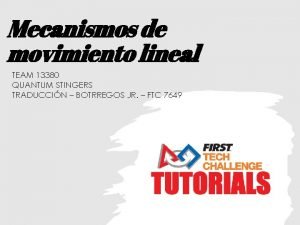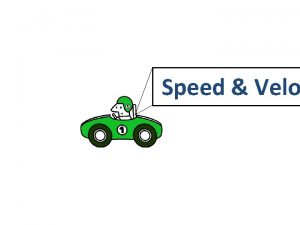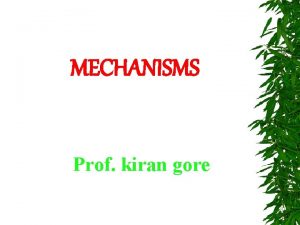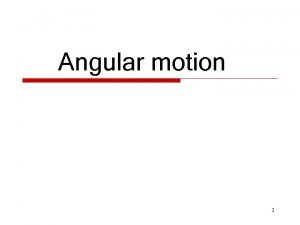Linear Motion Mechanisms TEAM 13380 QUANTUM STINGERS Linear












- Slides: 12

Linear Motion Mechanisms TEAM 13380 QUANTUM STINGERS

Linear Motion Mechanisms • Linear Motion is defined as motion in a straight line, as opposed to the circular motion produced by motors • There are many scenarios in FTC where linear motion is essential, and there also many different mechanisms that can produce linear motions • The main mechanisms include • • • Rack and Pinion Linear Actuator Scissor Lifts Linear Slides In this presentation, we’ll go over each mechanism, their pros and cons, and where they should be used

Rack and Pinion • • • The rack and pinion mechanism works by using a pinion (gear) which is attached to your motor to move a rack. Turning the gear allows the rack (attached to the extending piece) to move Advantages • • • Very Reliable when used for small movements As it runs on a gear system, it can make precise movements very consistently The system is strong, and can be used in places where high torque is needed Powered in both directions of movement Disadvantages • • Bulky and heavy Has a very limited range of motion Not many different models for FTC usage available on the market Racks are made of plastic and can break under too much pressure

Rack and Pinion • Ideal situations • • The rack and pinion mechanism should be used for short movements where a job must be done consistently It can be used in places where high torque but not too much extension is needed Here is an example of a robot that uses a rack and pinion. This robot is using the rack and pinion system to lift itself up 6 inches, displaying an ideal situation where it can be used. (Rover Ruckus Challenge) The Tetrix Rack and Pinion System can be purchased at: https: //www. pitsco. com/TETRI X-Rack-and-Pinion-Linear. Slide-Pack

Linear Actuators • • • Linear Actuators work using a lead screw. This lead screw works with a metal bar that extends outwards, forming a screw to bolt relationship. When the lead screw spins, the bolt either tightens or loosens, just like a bolt would in real life, causing the bolt (Metal bar) to travel up or down. Advantages • This system offer by far the most torque • The system is very reliable • Due to the friction on the lead screw, linear actuators can only move downwards when the motor spins, no matter how much force is put on it, which can be very useful when something must hold its position under duress or if the motor is not powered • Disadvantages • Linear Actuators are very slow • There is only one model that is FTC legal and available for teams

Linear Actuators • Ideal situations • The linear actuator system should be used in scenarios where power is of the utmost importance, but speed is not Here is an example of a robot that uses a linear actuator. This robot is using the mechanism to lift itself up 6 inches, just like the robot displayed previously. This team used a linear actuator instead of a rack and pinion as linear actuators give more torque, so could be used to lift up heavier robots The Servo. City linear actuator system can be purchased at: https: //www. servocity. com/li near-actuator-kit-7 -4 -stroke-60 -sec

Scissor Lifts • Scissor lifts are operated by either a rack and pinion or lead screw, which contract the scissor legs, causing upwards linear movement • One scissor leg is stationary, while one scissor leg is attached to the rack and pinion/lead screw. • Advantages • • Scissor lifts are high torque They can go very long distances Can be built to move very fast Disadvantages • • Significantly harder to build correctly than other mechanisms Not many kits available

Scissor Lifts • Ideal situations • The scissor lift should be used in situations where you need to move long distances and space is not the biggest concern Here is an example of a robot that uses the scissor lift This robot is using the mechanism to stack 8 inch tall blocks in a stack of at least 5. The scissor lift was effective here as it can go very high at a fast speed. (Sky. Stone Challenge)

Linear Slides • Linear slides work using a system of strings going stage to stage in a zig zag pattern. When the string is pulled, the stages will go up to compensate for the lost string. • Advantages • • Linear slides are fast and reliable They are compact, and you can add as many slides as needed to go up any target length Disadvantages • • • There are many available linear slide building kits They are only powered in one direction of motion. They can only go up, and you must use either surgical tubing or a second string to bring them down Linear slides are not the strongest mechanism There are 2 types of stringing for linear slides, each with their own advantages and disadvantages • • Elevator Stringing (Pictured on the right) Cascading Stringing (Pictured on the left)

Elevator vs Cascading • Elevator stringing • • This stringing method is simpler and only one slide moves at a time Since only one string is moving at a time, it is slower than cascading stringing Allows for much more precise movements Cascading Stringing • • • Each slide is strung to another slide, so when one moves they all move. Since every slide is moving at the same time, it requires much more energy than elevator stringing While much faster, it is harder to make precise and controlle movements

Linear Slides • Linear slides in general can be used anywhere that linear motion is required, but extreme power is not. They are the most versatile of the mechanisms and can be used almost everywhere Our team used linear slides in our robot to be able to stack up to 8 stones quickly and efficiently. As the stones were not very heavy and we did not have the space for a scissor lift, this was an ideal scenario where linear slides could be very useful. (Sky. Stone Challenge)

Credits • This lesson was written by Louis Law and Dhruv Gupta for FTCTutorials. com • You can contact the author at dhruv. gupta@norcalrobotics. org • More lessons for FIRST Tech Challenge are available at www. FTCtutorials. com This work is licensed under a Creative Commons Attribution-Non. Commercial-Share. Alike 4. 0 International License. Copyright 2020 FTCTutorials. com (Last edit 4/1/2020)
 Ksu culinary
Ksu culinary Quantum physics vs quantum mechanics
Quantum physics vs quantum mechanics Quantum physics vs quantum mechanics
Quantum physics vs quantum mechanics Going native project management
Going native project management Team spirit becomes team infatuation
Team spirit becomes team infatuation The white team cheers for the blue team, just like
The white team cheers for the blue team, just like Type of range of motion
Type of range of motion Shm formula
Shm formula An object in motion stays in motion
An object in motion stays in motion Chapter 2 section 1 describing motion answer key
Chapter 2 section 1 describing motion answer key The main difference between speed and velocity involves
The main difference between speed and velocity involves Section 1 describing motion answer key
Section 1 describing motion answer key Motion section 1 describing motion answer key
Motion section 1 describing motion answer key























